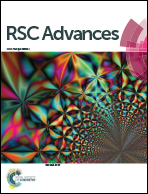TiO2@Sn3O4 nanorods vertically aligned on carbon fiber papers for enhanced photoelectrochemical performance
Abstract
Semiconductor heterostructures are regarded as an efficient way to improve the photocurrent in photoelectrochemical cell-type (PEC) photodetectors. To better utilize solar energy, TiO2@Sn3O4 arrays vertically aligned on carbon fiber papers were synthesized via a hydrothermal route with a two-step method and used as photoanodes in a self-powered photoelectrochemical cell-type (PEC) photodetector under visible light. TiO2@Sn3O4 heterostructures exhibit a stable photocurrent of 180 μA, which is a 4-fold increase with respect to that of the Sn3O4 nanoflakes on carbon paper, and a two-order increase with respect to that of the TiO2 NRs arrays. The evolution of hydrogen according to the photo-catalytic water-splitting process showed that Sn3O4/TiO2 heterostructures have a good photocatalytic hydrogen evolution activity with the rate of 5.23 μmol h−1, which is significantly larger than that of Sn3O4 nanoflakes (0.40 μmol h−1) and TiO2 nanorods (1.13 μmol h−1). Furthermore, the mechanism behind this was discussed. The detector has reproducible and flexible properties, as well as an enhanced photosensitive performance.



 Please wait while we load your content...
Please wait while we load your content...